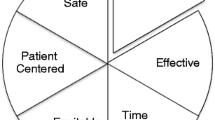Abstract
On the basis of state-wide longitudinal data from 80% of the hospitals in Kentucky, regression manpower models were developed. The results indicate that computers in hospital laboratories do not necessarily cut down on manpower needs but rather increase the number of higher-level manpower positions, those of medical technologists.
Similar content being viewed by others
References
Bartholomew, D. J., and Forbes, A. F.,Statistical Techniques for Manpower Planning Wiley, New York, 1979.
Burack, E., and Mathys, N.,Human Resource Planning: A Pragmatic Approach to Manpower Staffing and Development Brace Park Press, Lake Forest, Illinois, 1980.
Cohen, J., and Cohen, P.,Applied Multiple Regression/Correlation Analysis for the Behavioral Sciences Wiley, New York, 1975.
Dhrymes, P. J.,Econometrics: Statistical Foundations and Applications Harper & Row, New York, 1970.
Edwards, J., Leek, C., Loveridse, R., Lunly, R., Mansan, J., and Silver, M.,Manpower Planning Wiley, New York, 1983.
Fullerton, H. N., and Tschetter, J., The 1995 labor force: A second look.Monthly Lab. Rev. 106(11):3–10, 1983.
Gleich, C. S., and Routh, J. I., A statistical significance testing of hypotheses concerning clinical laboratory manpower.Am. J. M. T. 40:165–179, 1974.
Holmstrom, E.,The Information Gap in Allied Health Manpower (ERIC Document Reproduction Service No, ED 201 777). Health Resources Administration Division of Associated Health Professions, Hyattsville, Maryland, 1981.
Intrilligator, M. D.,Econometric Models, Techniques, and Applications Prentice-Hall, Englewood Cliffs, New Jersey, 1978.
Jonas, S., and Routh, J. I., A statistical significance testing of hypothesis concerning clinical laboratory manpower.Am. J. M. T. 40:156–158, 1974.
Kentucky Council on Higher Education,Allied Health Manpower Studies Final Progress Report, Author, Frankfort, Kentucky, 1982.
Kerlinger, F., and Pedhazur, E. J.,Multiple Regression in Behavioral Research Holt, Rinehart & Winston, New York, 1973.
Kerman, M. T., and Warner, A. R.,Report of National Conference on Health Manpower Distribution National Health Council, New York, 1976.
Kriesberg, H.,Methodological Approaches for Determining Health Manpower Supply and Requirements: Volume II: Practical Planning Manual (Publishing No. (HRA) 76-14512). USDHEW, Rockville, Maryland, 1976.
Levy, P. S., and Lemeshaw, S.,Sampling for Health Professionals Lifelong Learning, Belmont, California, 1980.
Lewis-Beck, M. S.,Applied Regression Sage, Beverly Hills, 1980.
Lithowski, T. I.,Study of Health Manpower Needs Methodologies. U.S. Department of Commerce National Technical Information Service, PR 80-106214.
Markoff, J., Standing on the edge of the automation precipice.Infoworld September 27:23–26, 1982.
Morrison, M. H., The aging of the US population: Human resource implications.Monthly Lab. Rev. 106(5):13–19, 1983.
Neter, J., and Wasserman, W.,Applied Linear Statistical Model Richard D. Irwin, Homewood, Illinois, 1974.
Nie, N. H.,Statistical Package for the Social Sciences McGraw-Hill, New York, 1975.
Schilderinck, J. H. F.,Regression and Factor Analysis in Econometrics Martinous Nijhoff Social Sciences Div., Liden, The Netherlands, 1977.
Schaeffer, R., Mendenhall, W., and Ott, L.,Elementary Survey Sampling Duxbury Press, North Sciuate, Massachusetts, 1979.
Snedcor, G. W., and Cochran, W. G.,Statistical Methods Iowa State University Press, Ames, 1981.
Venn, C.,Man, Education, and Manpower American Association of School Administrators, Washington, D.C., 1970.
Verhoven, G. J.,Techniques in Corporate Manpower Planning Kluwer Mijhoff, Boston, 1982.
Wheelwright, S. C., and Makridakis, S.,Forecasting Methods for Management 3rd ed. Wiley, New York, 1980.
Wolfe, D.,Can Professional Manpower Trends Be Predicted? Proceedings of U.S. Department of Labor Manpower Administration Seminar on Manpower Policy and Programs, Washington, D.C., 1967.
Younger, M. S.,A Handbook for Linear Regression Duxbury Press, North Sciuate, Massachusetts, 1977.
Author information
Authors and Affiliations
Rights and permissions
About this article
Cite this article
Morris, F.J. Impact of computerization on laboratory staffing. J Med Syst 10, 355–359 (1986). https://doi.org/10.1007/BF00992436
Issue Date:
DOI: https://doi.org/10.1007/BF00992436




